CLASS-XII BIOLOGY CHAPTER END TEST
CHAPTER-2: HUMAN REPRODUCTION
The given figure represents a stage of embryonic development. Identify the stage with its features. (1M)
Blastocysts, ready to fertilize with sperm.
Secondary oocyte, implants on the endometrial layer of the uterus.
Morula, formed by mitotic division of zygote.
Ovary, produce female gamete and secretes hormones like estrogen etc
Which of the following hormones is not secreted by human placenta? (1M)
hCG
Estrogens
Progesterone
LH
Spermiation is the process of the release of sperms from: (1M)
Seminiferous tubules
Vas deferens
Epididymis
Prostate gland
The figure given below depicts a diagrammatic sectional view of the female reproductive system of humans. Which one set of three parts out of A to F have been correctly identified? (1M)
C - Infundibulum, D - Fimbriae, E – Cervix
D - Oviductal funnel, E - Uterus, F – Cervix
A - Perimetrium, B - Myometrium, C - Fallopian tube
B - Endometrium, C - Infundibulum, D - Fimbriae
Define (i) Insemination (ii) Gestation (2M)
Mention any four functions of placenta. (2M)
Explain in detail the mechanisms of parturition. (3M)
Menstruation, also known as a period, is a natural process that occurs in the female body every month in preparation for pregnancy. Menstruation involves the shedding of the lining of the uterus, which is called the endometrium. This occurs when an egg that was not fertilized by sperm during ovulation is released from the ovaries and passes through the fallopian tubes into the uterus.
The endometrium then thickens in preparation for a fertilized egg to implant and develop into a pregnancy. If the egg is not fertilized, the uterus sheds the endometrium and the unfertilized egg, which is then expelled from the body as menstrual blood.
The menstrual cycle typically lasts between 21 and 35 days, with an average length of 28 days. The amount of menstrual blood and the duration of the menstrual period can vary from person to person. Menstruation can be accompanied by physical symptoms such as cramps, bloating, and mood swings.
While menstruation is a normal and natural process, it can also be a source of discomfort or inconvenience for some people. Many products, such as pads, tampons, and menstrual cups, are available to manage menstrual bleeding and help individuals to continue their daily activities during their periods. (4M)
What do you call the first and the last menstruations?
Can you always conclude the indication of pregnancy in absence of menstruation? Justify your answer.
Name the two gonadotropins involved in these cyclic changes of the uterus and ovary.
What is the fate of the corpus luteum in case of pregnancy?
Study the illustration given below and answer the questions that follow:(5M)
Identify ‘a’.
Name and state the function of ‘c’.
Identify 'd'.
Explain the role of hormones in the formation and release of 'a'.
Draw a diagram of 'b' separately and label the parts:
that helps its entry into 'a';
that carry genetic material;
that helps in its movement.















0 Comments